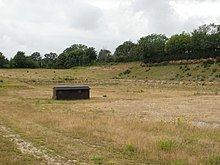Grid reference SU923087 Area of search West Sussex | Interest Geological Notification 1997 | |
 | ||
Amey's Eartham Pit is the original name for the internationally important Lower Palaeolithic archaeological site of Boxgrove in the English county of West Sussex. Today it is a disused, and largely infilled, sand and gravel quarry. Part of the site was designated a Site of Special Scientific Interest. When excavations began in 1982 flint tools 500,000 years old were discovered, which at that time was the oldest evidence of humans ever discovered in the UK. In 2005 flint tools 700,000 years old were discovered at Pakefield, and in 2010 flint tools at least 800,000 years old were discovered at Happisburgh. However Boxgrove remains a site of international archaeological importance because of the discovery in 1994 and 1995 of 500,000-year-old early human fossils, which remain the oldest such fossils ever discovered in the UK. The other key paleolithic sites in the UK are Swanscombe, Pontnewydd, Kents Cavern, Paviland, and Gough's Cave.
Contents
Parts of the site complex were excavated between 1982 and 1996 by a team led by Mark Roberts of the Institute of Archaeology, University College London. The site is situated in an area that features a buried chalk cliff that overlooked a flat beach (which contained a waterhole) stretching around half a mile (1 km) south to the sea.
HistoryEdit
The site is important for many reasons, including the degree of preservation of ancient landsurfaces, the impressive total extent of the palaeo-landscape beyond the quarries(over 26 km wide), its huge quantity of well-preserved animal bones, its numerous flint artifacts, and its hominin bones which are among some of the most ancient found yet in Europe. Several of the animal bones are the oldest found specimens of their species, such as the wing bone of the great auk found at the site in 1989. The combination of bones, stone artifacts, and the geology of the landscape gives a very complete picture of the coastal plain as it existed half a million years ago.
Numerous Acheulean flint tools and remains of animals dating to around 500,000 years ago were found at the site. Some of the bones were found to display cut marks, and some of the tools bear use wear traces indicative of cutting meat, indicating that the site was used for butchery by some of the earliest occupants of the British Isles. They shared the area with a wide variety of animals whose bones have been found there, including lion, bear, rhino and giant deer, as well as numerous smaller animals such as frog, vole and birds. Comparison with ethnographic and experimental examples of stone-tool-assisted butchery has shown that game animals at Boxgrove were expertly butchered, and it is likely that the variety of animal life in the area attracted human hunters. Evidence for hunting is, however, tentative, consisting primarily of a horse shoulderblade with a semicircular hole that has been interpreted as a projectile impact mark. No obvious hunting equipment has been found.
Remains of Homo heidelbergensis were first found on the site in 1993, comprising the partial tibia of a male who probably stood 1.8m high and weighed around 80 kg. Significantly, this is the only postcranial element of Homo Heidelbergensis to have been found in Northern Europe (in other words, coming from anywhere other than the skull). Both ends of the bone show signs of gnawing, possibly by a wolf, suggesting that perhaps the Boxgrove hominids were sometimes prey to other animals. In 1995 two incisor teeth from another individual were found. These show evidence of severe periodontal disease and show tool cut marks, which are thought to have been caused by use of flint tools near the mouth rather than indicate cannibalism.
In 2003 English Heritage announced it would buy the western quarry (known as Quarry 1) to ensure the preservation of the site complex.
ExcavationEdit
Roberts became the site director of the Boxgrove project.
In 2011, Roberts told interviewers from the student-produced archaeological magazine Artifact that Boxgrove was "a fickle mistress indeed" and that whilst he wouldn't change his experience in investigating the site, the excavations "extracted a very heavy price" from him, "a price that I am only just at the point of paying the final instalment on". For this reason he found that he often hummed The Specials' 1979 song "Too Much Too Young" to himself when thinking about the project.
PublicationEdit
In 1998, Roberts co-wrote a book about the site with prehistoric archaeologist Mike Pitts that was entitled Fairweather Eden: Life in Britain half a million years ago as revealed by the excavations at Boxgrove. Published by Arrow Books, Fairweather Eden was designed for a popular audience.
The English Heritage monograph: Boxgrove: A Middle Pleistocene hominid site at Eartham Quarry, Boxgrove, West Sussex is now available through the Archaeology Data Service.
